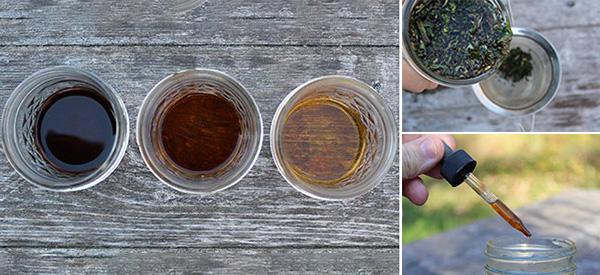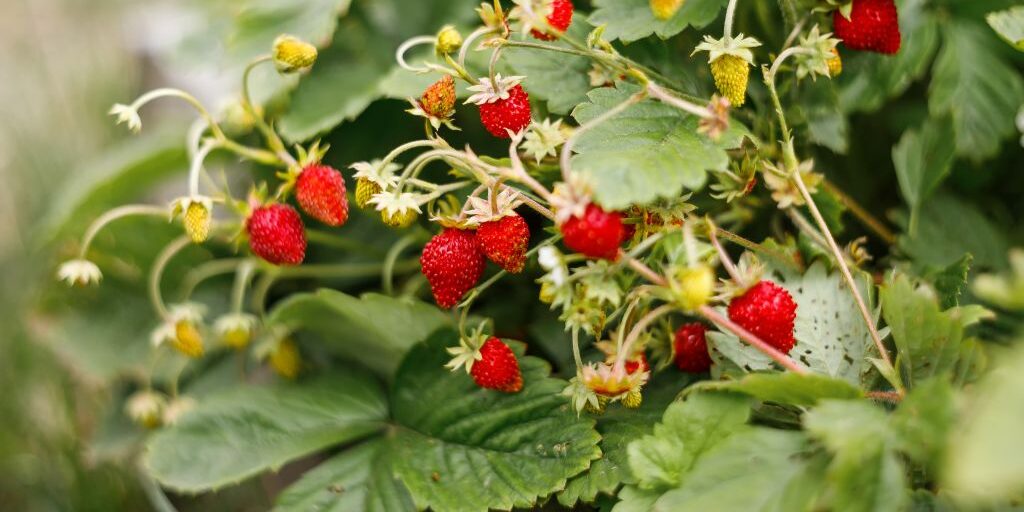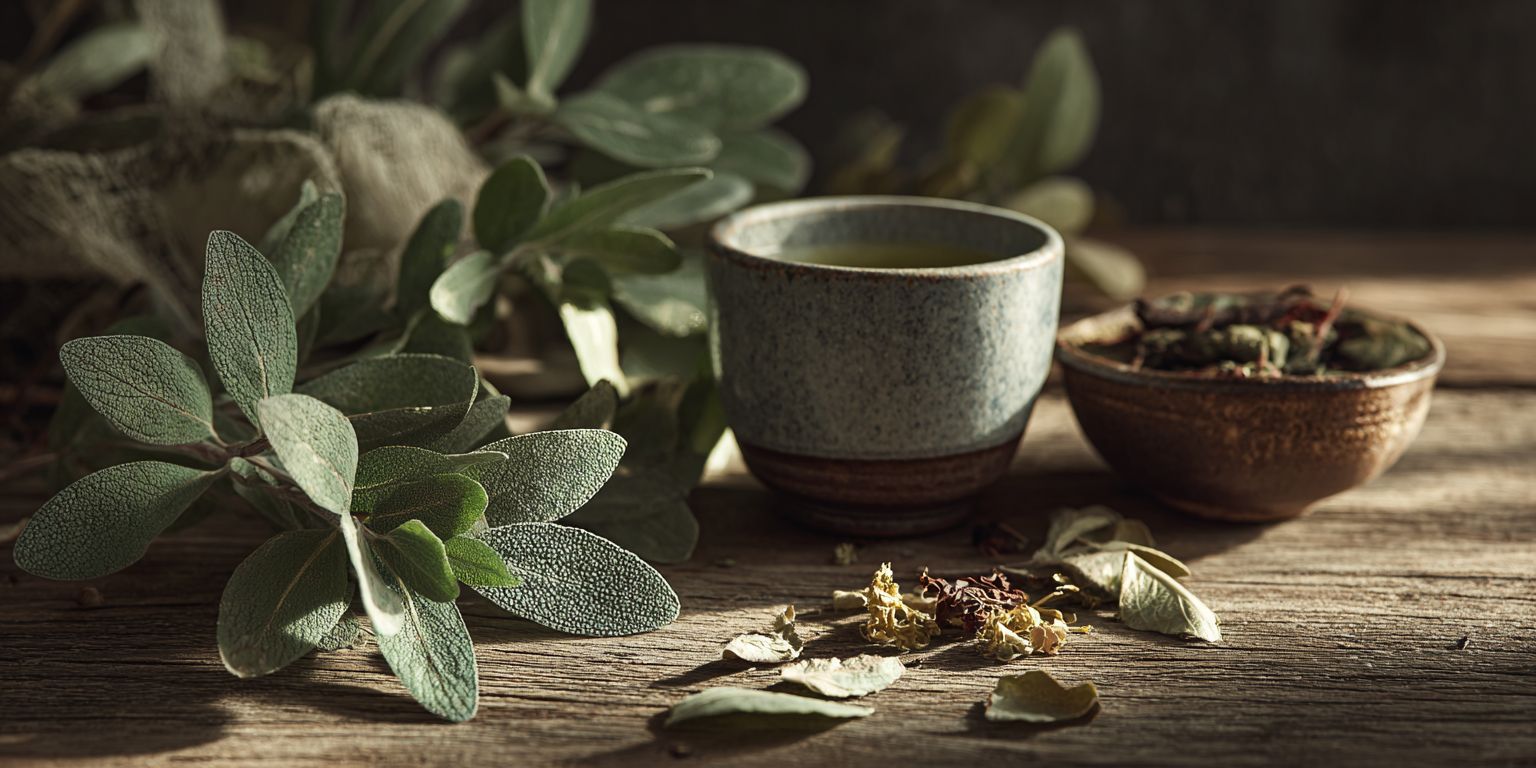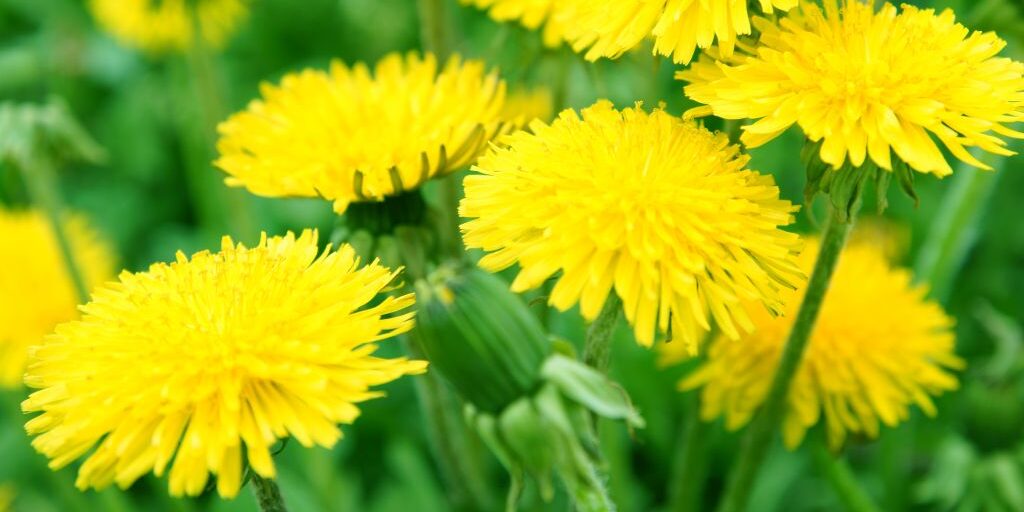
Dandelions
For many, the dandelion is just a stubborn weed in the lawn. But for herbalists, it’s a generous and resilient ally that has stood the test of time. This bright yellow plant has been used for centuries in traditional remedies across Europe, Asia, and the Americas—not just as a tonic, but as a food, a tea, and a medicine chest of its own.
Today, modern research is finally catching up to what our ancestors already knew: dandelions are a powerhouse of nutrients and a gentle, effective support for the liver, digestion, and overall vitality.
Dandelions are also remarkably adaptive. They grow in places other plants avoid—sidewalk cracks, gravel driveways, dry meadows. This resilience is a lesson in itself: healing is often hidden in plain sight. The dandelion doesn’t need pampering. It survives—and thrives—despite adversity, much like the communities that have relied on it for generations.
Where the Dandelion Is Found
Dandelions are native to Eurasia but are now found nearly everywhere in the world, from urban sidewalks and meadows to forest edges and alpine regions. They thrive in temperate climates and can grow in disturbed soils, cracks in pavement, and rich garden beds alike.
They are especially common in the Northern Hemisphere, flourishing across North America, Europe, and parts of Asia. Even in cities, they grow between bricks and in parks, offering medicinal value to anyone willing to look down. Their presence often indicates healthy, microbially active soil beneath the surface—even if it looks like just another patch of weeds.
Dandelions often appear after soil has been disturbed—whether by animals, construction, or tilling. In this way, they’re part of nature’s healing process. Their deep taproots help to break up compacted earth and draw nutrients up to the surface, benefitting the ecosystem around them. What’s often overlooked as a nuisance is, in fact, a restorer of balance.
How to Identify Dandelion
Dandelion is one of the easiest herbs to recognize, and also one of the most commonly misidentified. Here’s how to get it right:
- Leaves: Deeply toothed (hence the name “dent-de-lion” or “lion’s tooth”), forming a basal rosette close to the ground. Leaves are hairless and exude a white sap when broken.
- Flowers: Bright yellow composite blooms made up of many tiny ray florets. Each flower is borne singly on a hollow, leafless stalk.
- Stem: Milky latex-filled, not hairy, and unbranched.
- Seeds: The iconic fluffy seed heads—white puffballs that float away on the wind.
Unlike lookalikes, true dandelions never have branching flower stalks, and each flower grows on its own single stem. The leaves also grow only at the base of the plant, never up the flower stalk, which helps differentiate them from plants like wild lettuce or sow thistle.
Another telltale sign is the white, bitter sap that oozes from the stem or leaves when broken. This sap has its own traditional uses, particularly for topical skin issues. When identifying any wild plant, it’s important to observe multiple characteristics to avoid confusion—especially if you plan to harvest it for food or medicine.
How to Grow Dandelion
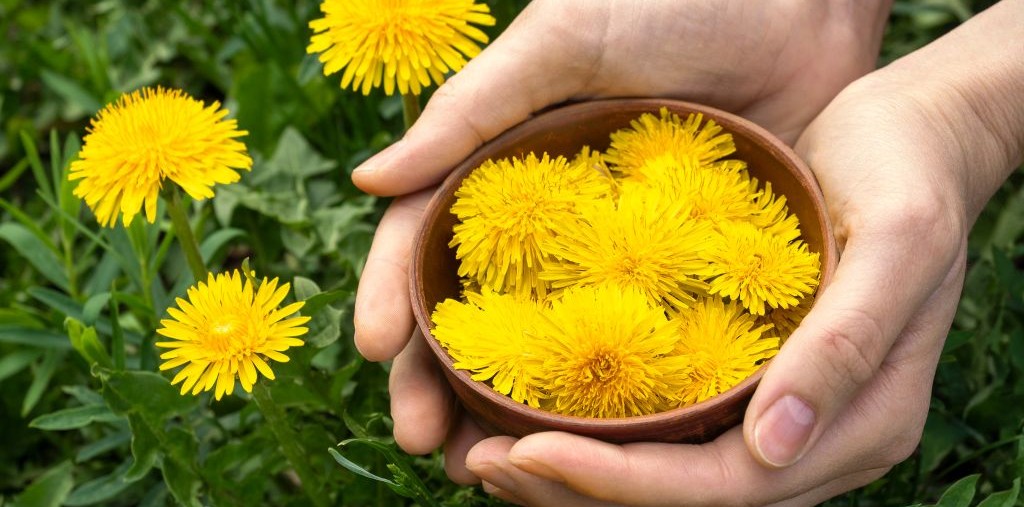 Growing dandelion is simple—it may already be growing in your yard! But if you want a more controlled harvest, here’s how:
Growing dandelion is simple—it may already be growing in your yard! But if you want a more controlled harvest, here’s how:
- Soil: Prefers loamy, well-drained soil with plenty of organic matter, but tolerates poor soils.
- Sun: Thrives in full sun, though it can tolerate partial shade.
- Planting: Sow seeds directly in the garden in early spring. Space them about 6–8 inches apart.
- Maintenance: Water regularly but avoid overwatering. Once established, dandelions are drought-tolerant and require little care.
You can start dandelion from seed indoors 4–6 weeks before the last frost, then transplant them outside. This method can help you control your crop and allow you to gather more uniform roots and leaves for medicine-making later. Choose a spot where the plant can grow freely—ideally in an herb bed, raised garden, or edge of the vegetable garden.
If growing for medicinal root harvest, it’s best to wait until the second year of growth. This allows the taproot to develop fully and accumulate beneficial compounds. In colder climates, mulching over the roots in late fall will help protect them for an early spring harvest.
Medicinal Benefits of Dandelion
Dandelion is rich in vitamins A, C, K, and minerals like potassium and iron. But beyond nutrition, it has been used medicinally in many ways:
- Liver Support: Dandelion root is a well-known liver tonic, promoting bile flow and aiding in detoxification.
- Digestive Aid: Dandelion stimulates appetite and supports digestion, relieving bloating and constipation.
- Anti-inflammatory: Studies suggest dandelion contains compounds that help reduce inflammation and modulate the immune system.
- Diuretic: The leaves act as a gentle diuretic, often used to reduce water retention and support kidney health.
- Skin Health: Applied topically, dandelion sap has been used to treat warts, acne, and eczema.
- Blood Sugar Balance: Preliminary research shows promise in supporting insulin sensitivity and lowering blood sugar levels.
Traditional Chinese Medicine and Native American herbalism both used dandelion as a cooling herb, clearing heat from the body and reducing swelling. In modern terms, this supports its use as an anti-inflammatory and lymphatic mover—especially helpful for swollen glands or sluggish lymph systems.
Additionally, the antioxidant content of dandelion helps combat oxidative stress, which contributes to chronic conditions like heart disease and aging-related degeneration. In this way, the humble dandelion plays a supporting role in whole-body wellness, protecting organs and gently supporting detox pathways without harsh side effects.
What Parts of Dandelion Are Used for Remedies?
Each part of the plant offers its own healing properties:
| Part Used | Medicinal Properties | How to Use |
| Leaves | Diuretic, mineral-rich, detoxifying | Eaten fresh, dried for tea, or tinctured |
| Flowers | Antioxidant, skin-soothing, mood-lifting | Infused in oils, made into salves or wine |
| Roots | Liver tonic, digestive bitter, mild laxative | Dried and decocted, roasted for herbal coffee |
| Sap | Latex, skin-treating | Applied fresh to skin (warts, pimples) |
The entire plant is edible and medicinal, which is rare and valuable in herbal medicine. Young leaves in spring are less bitter and can be tossed into salads or juiced. The flowers are rich in flavonoids and are often made into infused honey, syrups, or even baked goods.
Dandelion roots, especially from older plants, can be dried and roasted as a coffee alternative—this has a long history in traditional Western herbalism. They stimulate digestion and gently support detoxification. The fresh sap from the stem has been used topically, but care should be taken if you have sensitive skin.
Plants That Resemble Dandelions
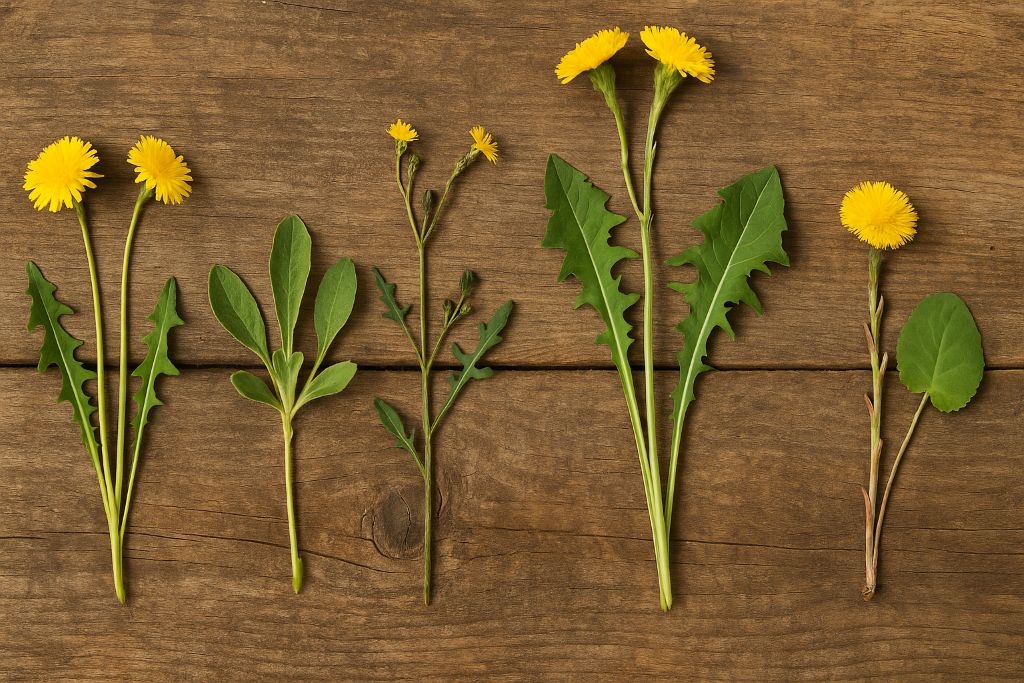 Be cautious—many plants mimic the dandelion’s appearance, especially in the flower stage. Use the chart below to avoid confusion:
Be cautious—many plants mimic the dandelion’s appearance, especially in the flower stage. Use the chart below to avoid confusion:
| Lookalike Plant | Key Differences | Safe to Use? |
| Cat’s Ear (Hypochaeris radicata) | Hairy leaves and branching flower stems | Yes, edible |
| Hawkweed (Hieracium spp.) | Hairy stems, smaller flowers, grows in clusters | Some edible uses |
| Sow Thistle (Sonchus spp.) | Taller growth, spiny leaves, milky sap | Yes, but milder |
| Coltsfoot (Tussilago farfara) | Flowers appear before leaves, rounded basal leaves | Medicinal, not culinary |
| False Dandelion (Agoseris spp.) | Similar flowers, but stems branch and are not hollow | Some edible uses |
To further confirm your identification, examine the root system—true dandelions have a thick, deep taproot, while many lookalikes have fibrous or rhizomatous roots. Also, observe the growth pattern: dandelions grow in solitary form, not in clumps or branching heads.
Proper identification is key, especially if you’re using dandelions for internal remedies. A mistake can be as simple as assuming a similar flower means a similar effect, which isn’t always true in herbalism. When in doubt, consult a local foraging guide or herbalist.
Reclaiming Forgotten Medicine In Your Home Garden: Why This Matters Now
We’re watching our natural world be stripped, patented, and sold back to us—sterilized and weakened. But nature hasn’t forgotten us. Dandelions haven’t stopped growing, haven’t stopped healing, and certainly haven’t lost their power.
And they’re just one of the hundreds of remedies hidden in our own backyards—many of which are featured in The Forgotten Home Apothecary, a book I believe every serious herbalist, prepper, and mother should have. It’s not just a book. It’s a survival guide, a teacher, and a memory keeper of remedies they don’t want you to know.
👉 Click here to get your copy of The Forgotten Home Apothecary
Before another remedy disappears.
This is more than herbal folklore—it’s ancestral knowledge being preserved. Books like this teach us not only how to use plants like dandelion but how to connect with the land again, reclaiming our independence from industrial medicine and corporate food systems. When you open this book, you’re opening a living library.
Final Thoughts
The humble dandelion has been underestimated for too long. Whether growing wild in your yard or cultivated in a patch of soil, it offers a powerful set of healing gifts—from liver support and digestion to skin care and diuretic action. And best of all, it asks for very little in return.
It’s a reminder that wellness doesn’t have to be complicated or expensive. Sometimes the best medicine is the one growing right under your feet. Learning to use dandelion is a small but meaningful way to reconnect with your health—and with the Earth.
Let dandelion be your teacher. Its resilience, usefulness, and simplicity embody the very heart of herbal living: slow, steady, and rooted in nature.
DIY Medicinal Pickled Dandelion
How To Keep Mosquitoes Away With Cattails (Video)







